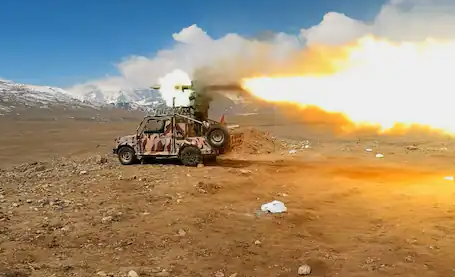Indian Army’s Trishakti Corps conducts missile firing exercise in Sikkim
The Trishakti Corps of the Indian Army recently conducted a training exercise on Anti-Tank Guided Missile (ATGM) firing at a Super High-Altitude Area of 17,000 Feet in Sikkim.
The exercise involved Missile Firing Detachments from Mechanized and Infantry Units of the entire Eastern Command, showcasing the capability to neutralize armoured threats with high lethality in treacherous mountainous terrains. The training included continuity training and live firing from different platforms on both moving and static targets to simulate battlefield conditions.
The exercise was conducted with the aim of “Ek Missile Ek Tank” and highlighted the accuracy and effectiveness of the ATGM system in high-altitude environments.
The successful demonstration of the ATGM system’s performance in Super High-Altitude terrain further strengthens the Indian Army’s readiness and preparedness in dealing with potential threats in challenging terrains.
About Trishakti Corps
Trishakti Corps is a key military formation of the Indian Army, comprising three divisions – 17th Mountain Division, 27th Mountain Division, and 72nd Mountain Division. It is headquartered at Sukna in West Bengal and operates along the eastern borders of India.
Trishakti Corps plays a crucial role in ensuring the security of the Siliguri Corridor, also known as the Chicken’s Neck, which is a narrow strip of land connecting the northeastern states of India to the mainland. This strategic location makes Trishakti Corps a critical component of India’s defense strategy.
Anti-Tank Guided Missile
An Anti-Tank Guided Missile (ATGM) is a precision weapon designed to destroy enemy tanks and armoured vehicles. It typically consists of a missile, a guidance system, and launch platform such as a vehicle or portable launcher. ATGMs use sophisticated technology to accurately strike targets at long ranges. They are highly effective against armoured vehicles due to their ability to penetrate thick armour with a shaped charge or explosive warhead. ATGMs are widely used by military forces around the world to counter armoured threats on the battlefield.
Here are some of India’s ATGMs
- Nag: Nag is a third-generation, fire-and-forget, top-attack ATGM with a range of 4-7 km. It is developed by India’s Defence Research and Development Organisation (DRDO).
- HELINA (Helicopter-launched Nag): A variant of the Nag missile designed to be launched from helicopters, with a range of 7-8 km.
- MPATGM (Man Portable Anti-Tank Guided Missile): A third-generation, fire-and-forget, infantry-operated ATGM with a range of 2.5 km, also developed by DRDO.
- SANT (Stand-off Anti-Tank): A missile system designed to be launched from the air, with a range of 15-20 km.
- SAMHO (Semi-Active Homing): A second-generation ATGM with a range of 4-5 km, developed by Bharat Dynamics Limited (BDL).
- MILAN 2T: A second-generation, wire-guided ATGM with a range of 2 km. It is a licensed version of the French MILAN missile, manufactured by BDL.
- Konkurs-M: A second-generation, wire-guided ATGM with a range of 4 km. It is a licensed version of the Russian 9M113 Konkurs, manufactured by BDL.
About Sikkim
Sikkim is a state in northeastern India, bordered by Bhutan, Tibet, and Nepal. Sikkim became a part of India in 1975. Gangtok is the capital and largest city of the state. The economy relies heavily on agriculture, tourism, and hydroelectric power. Sikkim is also known for its rich biodiversity, with numerous rare plant and animal species. The official language is Nepali, and Buddhism is a prominent religion in the region.
Month: Current Affairs - April, 2024
Category: Defence Current Affairs


